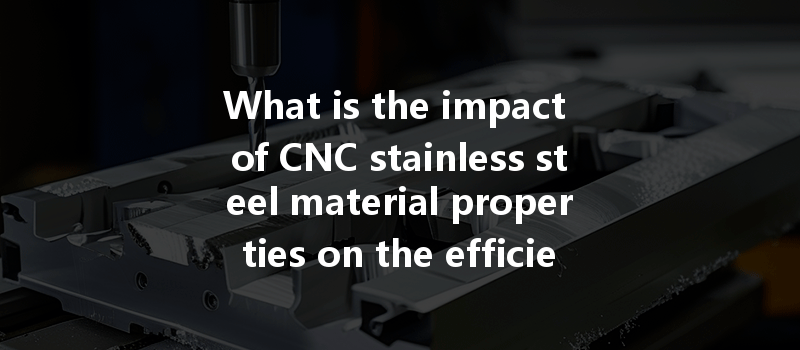Did you know that stainless steel accounts for approximately 70% of all metal fabrication processed in the United States? Yet, despite this prevalence, many manufacturers often overlook the importance of understanding the material properties of CNC stainless steel when it comes to machining efficiency. The ability to harness the unique characteristics of stainless steel can significantly optimize production processes, reduce costs, and enhance the quality of the finished products. In this blog, we will delve deep into the impact of CNC stainless steel material properties on machining efficiency, how to leverage those properties, and practical solutions to improve your machining processes.
Understanding the Basics of CNC Machining
Before we explore the intricacies of CNC stainless steel properties, it’s fundamental to grasp the principles of CNC (Computer Numerical Control) machining itself. CNC machining involves the automated control of machining tools using a computer. It enables high-precision, repeatable work that can be performed on various materials, including metals, plastics, and composites.
CNC machining encompasses a variety of processes, including milling, turning, drilling, and grinding. Each of these processes can be tailored to accommodate the specific characteristics of the materials being used, which brings us back to stainless steel.
The Material Properties of Stainless Steel
Stainless steel is revered for its exceptional resistance to corrosion, high durability, and aesthetic appeal. However, it comes in various grades, each with distinct compositions that influence its machinability. Understanding these properties can help manufacturers determine the optimal machining strategies to improve efficiency.
Composition and Grades of Stainless Steel
There are several grades of stainless steel, each with different chemical compositions:
Critical Material Properties Affecting Machining Efficiency
The Importance of Tool Selection and Cutting Parameters
Choosing the correct tools and cutting parameters is crucial when machining stainless steel. The following factors should be considered:
Strategies to Enhance Machining Efficiency
With a sound understanding of the material properties of stainless steel, here are practical strategies to enhance machining efficiency:

Through trial and error, along with data analysis, manufacturers can discover the optimal cutting speeds and feed rates for specific stainless steel grades. Employing CNC software allows for simulation and adjustment of these parameters before taking the process live, minimizing potential errors.
It is crucial to select high-quality tooling that is resistant to wear and breaks. By investing in carbide or coated tools, machinists can significantly reduce tool wear and achieve greater precision, ultimately leading to longer tool life.
Implementing modern machining techniques such as high-speed machining (HSM) or dry machining can improve efficiency. High-speed machining allows for faster spindle speeds, ultimately reducing cycle times.
Regular maintenance of CNC machines and tools ensures they operate at peak performance. This includes sharpening or replacing worn tools, cleaning machine components, and maintaining appropriate fluid levels.
Heat management is crucial in stainless steel machining due to the material’s low thermal conductivity. Utilize high-quality coolants, and consider setting up in-process temperature monitoring systems to prevent overheating, which could lead to part defects.
Implementing a quality management system that continuously monitors machining processes can lead to better overall output. By analyzing production data, manufacturers can make informed adjustments that can enhance efficiency.
The integration of automation into CNC machining processes allows for greater precision and efficiency. Automated tool changers, advanced clamping systems, and robotic arms reduce manual intervention, resulting in faster cycle times.
Investing in staff training ensures that operators understand the properties of the materials they work with. Skilled operators can provide insights into optimizing processes based on real-time observations.
Case Studies: Success Stories in CNC Machining of Stainless Steel
Case Study 1: Aerospace Component Production
A leading aerospace manufacturer faced challenges with machining stainless steel components for jet engines, resulting in high cycle times and tool wear. By optimizing cutting parameters and switching to high-quality carbide tooling, they were able to reduce production time by 30% while extending tool life by 50%.
Case Study 2: Medical Device Manufacturing
A medical device firm had difficulties producing precision components from stainless steel due to inconsistent surface finishes. After implementing an advanced coolant system and focusing on employee training, they achieved a more uniform surface finish, which increased product reliability and customer satisfaction.
Understanding the material properties of CNC stainless steel and their impact on machining efficiency is essential for manufacturers aiming to enhance productivity, reduce waste, and ensure quality. By employing appropriate cutting tools, optimizing parameters, and implementing modern machining strategies, businesses can significantly improve their processes.
The insights and strategies covered in this blog highlight the crucial relationship between material properties and machining performance. Embracing these practices not only leads to efficiency gains but also empowers manufacturers to compete more effectively in today’s demanding market landscape.
In a world where every detail matters, the ability to understand and manipulate the properties of materials like stainless steel will become a cornerstone of successful CNC machining. Therefore, it is paramount for manufacturers to evaluate their current practices, stay updated on industry innovations, and continuously strive for excellence in their machining processes.






